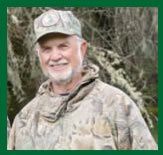Big Game Outlook — 2010
by Terry Knight
California’s deer and wild pig hunters should enjoy a banner
season this fall. The heavier than normal spring rains have
created an abundant amount of feed and there is also plenty of
water. That’s the good news. The bad news is that the state’s
deer still haven’t completely recovered.  What does this mean to
the average Wilderness Unlimited hunter? It means that hunters
will have do their homework in regards to selecting what zone
they want to hunt and which ranches to hunt. Just about all the
W.U.’s leased properties offer excellent hunting so selecting a
ranch to hunt should be no problem.
What does this mean to
the average Wilderness Unlimited hunter? It means that hunters
will have do their homework in regards to selecting what zone
they want to hunt and which ranches to hunt. Just about all the
W.U.’s leased properties offer excellent hunting so selecting a
ranch to hunt should be no problem.
Picking the time of the season to hunt is also critical in being successful. Typically the first part of the season (be it any of the zones) is not the best time to hunt. Often the weather is searing hot and the deer are holding tight. However, by the last third of the season the bucks are normally starting to go into rut and the weather is comfortable.
Knowing the deer’s habits and being familiar with the area you plan on hunting will go a long ways toward bringing home the venison. If you’re new to a particular ranch, plan on spending your first day getting familiar with the terrain and the roads. The result is that on subsequent trips you will be able to find your favorite hunting area in the dark. Also, plan on being in the woods well before daylight and hunt until dark. You can spend the middle of the day resting in camp. Deer are most active early in the mornings and the last hour before dark. During the hottest time of the day they will normally hole up in an area where they can get a slight breeze. That’s not to say bucks can’t be taken during the day. Any change in the weather will cause deer to change their feeding habits.
Many hunters spend most of their time driving around the ranch and looking for a buck standing under a tree. While there are hunters that are successful road hunting, most of the time all you will see are a few does and fawns. In other words get off the roads and do a little hiking. Even a short hike of 30 minutes will usually put you far enough off the roads so that the deer won’t be alarmed.
Ridges are great places to slowly walk and glass with your binoculars. Glass down in the little draws and open areas. Often you will see a buck either feeding or bedded down. Experienced hunters often like to hunt what are called the “edges.” These are areas where there is food, water and cover. For example the edge of a burn with heavy cover nearby is good habitat for a buck. Normally a buck won’t go very far out in the burn itself but he will feed on the edges where he can escape back to the cover in a flash.
Many of the more successful hunters will sit and glass a hillside for hours. Here is where patience pays off. Find an area where you can sit comfortably and watch a far hillside. Be sure and have the sun at your back. In other words in the morning face the west and in the evening face the east. When the sun first breaks over a ridge top in the mornings, a deer standing on far hillside will stick out like a fireball. The same applies in the evenings.
When glassing a hillside look for anything out of the ordinary. If you see something that just doesn’t look right, zero in on it with your binoculars. More than once I have sat on a hillside for an hour or longer and then noticed a buck bedded down under a tree or some brush. Often the flicker of his ear or a slight movement of his head will give him away. The best part of using this technique is that often the deer isn’t aware of your presence and will offer a good shot.
If you’re hunting a large ranch, tell the patrolman or leave a note in your camp on where you will be hunting and when you plan to return. Accidents can happen in a flash and on a 10,000-acre ranch it could take days to locate you.
